|| BACK TO HOMEPAGE ||
It contains information on all edible plants of Poland (about 1000 species out of nearly 3000 in the country's flora). A separate chapter on the collection and preparation of food was added. The book contains a lot of little known surprising data on the use of wild plants by Native Americans and the tribes of Siberia. The book has 236 pages (A5) and 100 black-and-white drawings. It can be ordered at the publisher's, Chemigrafia . It costs 35 zl ($12)including postage within the area of Poland (paid on delivery).
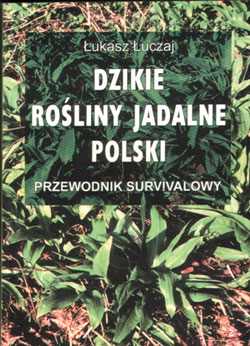
A FEW SELECTED ENTRIES TRANSLATED INTO ENGLISH OUT OF 400 IN THE BOOK:
oak
bracken
cattail
hogweed
lily
ramsons
The fruits of oaks, acorns, have been used by primitive societies throughout the world as a rich source of starch, their role corresponding to that of potatoes in northern Europe. In fruiting years, which occur every 2-3 years in central Europe, one can collect about ten buckets of acorns in 8 hours (personal experiment). The main problem in eating acorns lies in the fact that they contain tannin, like tea or red wine (matured in oak barrels!) It is not particularly poisonous but gives them a bitter taste and can cause constipation in larger quantitities. Tannin rich products have actually been used in curing stomach upsets as tannin is astringent. The only truly "sweet" oak, without bitterness, is burr oak Quercus macrocarpa from the area of the Great Lakes in America. It is sometimes planted in European parks (in Poland in Wilanów and Krasiczyn). Selected specimens of practically all species were found to be without, or nearly without, bitterness. You are very likely to find nicely tasting acorns of such southern European species as Quercus pubescens or Quercus ilex. For some native tribes of California acorns were the most important food. They built giant raised baskets where they stored their crops. Pauites kept acorns in holes walled by sage leaves. Some natives such as Cowlitz and Paiute kept acorns for years, buried in boggy ground. They turned black but were still perfectly palatable. Acorns were used in prehistoric times in Europe as well but this has been totally forgotten. There are a few methods of leaching (removing tannin from acorns). The easiest way is to cook halved acorns in lye (ie water with a few spoonfuls of deciduous ash). One gets the best lye from lime tree ash.
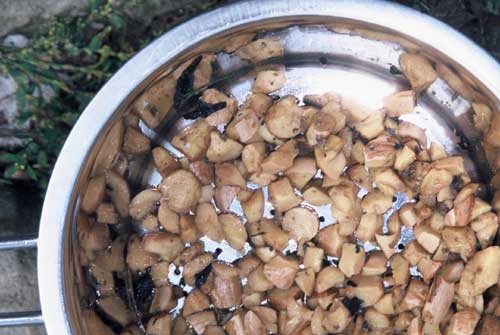
Acorns after leaching with lime tree ash, ready to eat.
The procedure actually varied from tribe to tribe. Some Indians soaked wholed husked acorns in lye, rinsed and cooked them, and some leached already crushed acorns. The Shasta Indians crushed acorns together with their shells and then winnowed them. Boiled acorns are rather tasteless, a little bit like boiled cereals, but they can be a nutritious base for various dishes. American Indians often ate them with meat and maple syrup.
Bracken Pteridium aquilinum is one of the most cosmopolitan plants of the world, as it grows in various vegetation types from tundra to tropical forest, from Alaska to New Zealand. Bracken, especially its spores, is carcinogenic. However it has been used as food by dozens of nations throughout the globe.
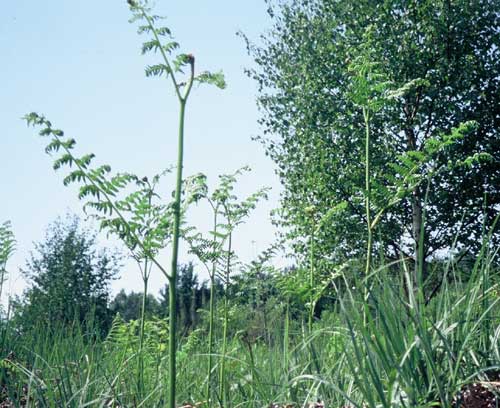
Its dried rhizomes contain about 60% starch. Unfortunately they are very bitter, though most of this bitterness can be get rid of by thorough preparation. The rhizomes have often been eaten after being dried, peeled and threshed. The starch then separates from the hard fibres. Dealing with small quantities of the stuff may be very laborious but with sufficient bulk quantities it must have been turned into real industry. My humble experiments showed that you can easily dig out 6-7 kg of fresh rhizomes per hour from a field margin in the Carpathian foothills. I have heard that bracken in the Canary Islands is more robust... Because of its nutritive value and commonness (West European pastures are often infested by extensive patches of bracken) the rhizomes were often used as food. In 1683 in some parts of France there was such poverty that the Prince of Orleans gave Louis the fifteenth a piece of bracken bread saying: �Lord this is what your subjects eat.� In Siberia they used to brew bracken beer combining bracken rhizomes and cereals. Bracken was especially important in the Canary Islands. In the islands of Palma and Gomera the local inhabitants used to make �gofio� bread from bracken rhizomes and barley. In 1405 Betancon noted that the inhabitants of the Canary Islands lived mainly on bracken: �as far as grain is concerned they have got none, their bread is made from fern roots�). The rhizomes were also eaten by North American Indians (e.g. Hesquiat, Nitinaht and Thompson) who baked or cooked them. They were also eaten by the aboriginal inhabitants of New Zealand!
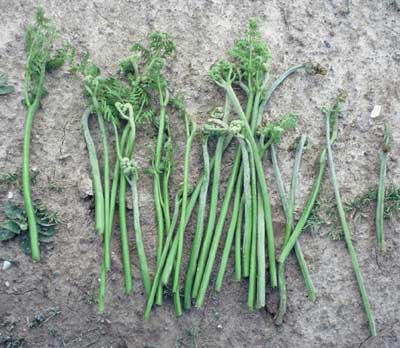
Another edible part of bracken is the young fronds. They come out of the ground quite late (about the first of May in Poland) and are edible for about two weeks (until they grow taller than 20 cm). When the fronds are very fragile it means they are palatable. When they break with difficulty and unevenly, it is too late. Raw fronds are bitter and carcinogenic. They also contain tiaminase (like all other ferns), which is an enzyme which breaks down vitamin B1. They are edible after leaching (cooking with a spoonful of deciduous wood ash, which should be rinsed later). These young leaves were eaten by poor miners in California, and they are appreciated in Japan (the dish made of them is called �warabe�). Raw (!) or cooked fronds were eaten by Native Americans (e.g. Costanoan, Salish, Ojibwa). Ojibwa hunters would feed on the fronds at least for a few days before spring hunting because then the doe, which feeds on bracken, would not smell them.
CATTAIL Typha
A few species of cattail grow throughout the world on the edges of ponds and lakes. The two commonest species, the only ones that occur in Poland, are broad-leaved cattail Typha latifolia and narrow-leaved cattail Typha angustifolia.
Cattails are one of the most important and easiest to obtain sources of food in the wild. All their parts are edible unless they are too old and hard.
Their rhizomes, a little bit thicker than a thumb, are edible, both raw or, better, cooked. They were used by many nations, including early settlers of Virginia and Native Americans. They should only be dug from autumn till spring. The only problem is that in this period of the year the water is usually cold, so putting your hands or legs in it is very unpleasant. Unfortunately in summer the rhizomes are flaccid and no good. All the goodness is in the shoots by then. The rhizomes usually grow in stinking mud so they should be well cleaned. The dried root is usually dried and pounded into flour, later made into mush (that is how it was used by the Paiute Indians). The Cree Indians would store whole roots for winter. One hectare of cattails can yield 8 tonnes of rhizomes, which contain 55-80% of carbohydrates (30-46% starch) and 6-8% protein. The cattail flour can also be added to cereal flour for making bread. The whole cattail rhizomes are not as easy to eat as potatoes. They contain long cellulose fibres. There are three ways of dealing with them. One way is to chew the roots and spit out the fibres. The second one is to slice the rhizomes so that fibres are very short and easy to swallow. The third way is to turn roots into soup stock or flour and to discard the fibres.

Peeled cattail rhizomes
The powdered cattail rhizomes, together with the roots of greater burnet Sanguisorba officinalis, Butomus umbellatus and two species of lilies, Lilium spectabile and L. martagon, were used by Yakuts in the 19th century Siberia to make a dish called "butagas". 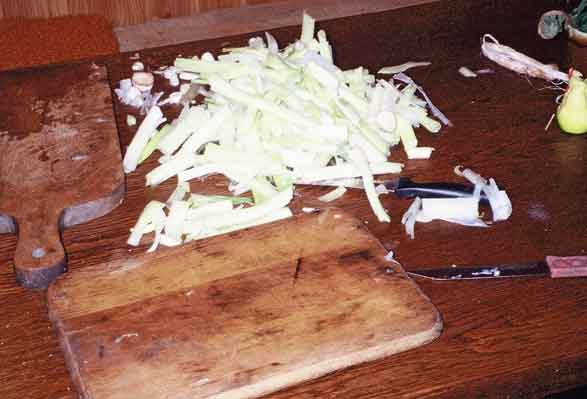
Bases of young cattail leaves make very good vegetable soup.
The tastiest parts of cattail are the young shoots. They taste like potatoes cooked with mussels. They should be gathered between April and June. Later they become too hard except for occasional new growth to be found here and there. The shoots look like gigantic leek and we treat them similarly, cutting off the green bits and leaving only the juiciest ones at the base, the whitest 5-20 cm. The later we collect the shoots, the more hard layers we have to discard. How to tell which layers are palatable? The core should be so soft that you can easily break it and chew it. If you cannot, it means you have some hard stuff left. In the beginning of summer the edible core is as thin as a pencil, in August all the layers are too hard. One of the English names of cattails is �Cossack asparagus� as they were Cossacks� traditional vegetable. An English traveller who visited Ukraine (probably in the 19th century) said that cattails were eaten in spring with �religious passion� and they were visible everywhere, stacked in each yard. Another delicious part of cattail are the young female inflorescences, cylindrical �clubs�. They can be eaten both raw and cooked and taste not that different from maize. Yellow cattail pollen is a very nutritious, protein-rich food. It is easy to miss it as it is produced only for a week or so. It can be simply patted off onto a plate. Cattail pollen cakes are a popular food in South-east Asia. Even cattail�s tiny seeds are edible. American Indians would knead them into small cakes baked on embers or turn them into gruel or soup. In order to get rid of the fluff attached to the seeds, they used to throw them into a sack together with embers, which after shaking would burn all the fluff off, leaving the seeds.
HOGWEED Heracleum
The common hogweed Heracleum sphondylium is widespread in meadows, field margins and roadsides. It occurs both in Eurasia and North America. Hogweed is a forgotten vegetable, once very important to Slavs. The word �borsch� (beetroot soup) derives from this word. Cooked hogweed leaves and stalks make wonderful soup, green-brown in colour, one of my favourite survival dishes. The raw plant can also be eaten, but is not as good. Larger quantities can irritate your throat. Gerarde, the 16th century author of a famous herbal guide reported that in Poland, Russian and Lithuania hogweed was commonly eaten fermented. The chopped stalks, flowers and leaves were put into barrels, covered by water and fermented for a couple of days. The fermented hogweed is something between beer and sauerkraut, as it contains both alcohol and lactic acid. In Lithuania and Russia it was fermented along with blueberries and, in Kamtchatka, with the berries of Lonicera coerulea.

Hogweed is extremely common in fertile meadows, hedges and neglected gardens.
Captain Cook reported that hogweed was the main vegetable of Kamtchatka, eaten with all dishes. When the peninsula was overtaken by Russians hogweed was used for the production of alcohol. In Russia and Siberia its leaf stalks were dried in the sun in bundles until they got yellow and a sugary substance formed on their surface. Then they were eaten as a treat. Hogweed seeds are very aromatic, though I have not found a record of their use in literature. Once I dried a bunch of them by accident. They smelt of anis so I put them into a ˝ bottle of vodka and added 2 tablespoonfuls of honey. They produced one of the best liquors I know. I make it every year now. The American subspecies of the common hogweed was often treated as a separate species: Heracleum maximum or H. lanatum. It used to be eaten by about 30 tribes of the West coast of North America. Its peeled stalks or young shoots were dried or cooked. For the Okanagon , Haisla and Hanaksiala Indians it was one of their basic spring foods. The Thompson Indians ate it only until June as later it becomes hard. They avoided eating raw hogweed. There is another species of hogweed, known as the giant hogweed Heracleum mantegazzianum. It comes from Caucasus and tends to escape from cultivation in Europe. It is scattered throughout Poland, especially near former collective farms where it was grown as fodder. The biggest area of giant hogweed can be found in the Beskid Niski Mountains, especially in Zawadka Rymanowska. The giant hogweed�s shoots contain furanocumarins which cause skin rashes. People with pale skin are particularly sensitive (lips are often affected). Being splashed by hogweed sap when cutting it can cause very painful blisters. Presumably giant hogweed is edible after cooking but I have always been too scared to give it a try. The common hogweed also contains these harmful substances but in much lower quantities.
LILY Lilium
There are only two wild species of lily in Poland - Turkish cap Lilium martagon (scattered in woods throughout the country, protected) and Lilium bulbiferum, restricted to a few localities in the Tatra and Sudety mountains. Numerous species of lilies are grown in gardens, though.
Lily bulbs are one of the best wild sources of starch. After cooking they taste much like mashed potatoes. They can be dried for later use. We must bear in mind that digging out the bulb ends the plant�s life, so it is important not to dig out wild growing specimens in countries where they are rare.
Turkish cap bulbs were eaten by Cossacks from the Volga area and by the Yakuts (in Eastern Siberia). Although they are small (wild growing bulbs weigh something between 2 and 15 g, so in order to get an equivalent of a kilogram of potatoes you would have to destroy 150 plants, fortunately some other cultivated species have bigger bulbs) they are easier to prepare than potatoes, as you do not have to peel them. You should cook them for about an hour until they stop being crunchy and become soft and creamy.
Numerous lily species are grown as a vegetable in Japan and China (Lilium bulbiferum, L. tigrinum, L. auratum, L. concolor, L. lancifolium, L. speciosum). Lilium pomponium was (or is?) eaten by the Chinese, Tartars and in Kamtchatka. Lily bulbs are one of the components of "namono" - a dish served at the Japanese New Year celebrations. Lily starch is used there to make cakes.

RAMSONS (WILD GARLIC) Allium ursinum
Ramson belongs to the same genus as garlic and onion. It does not look much like them as it has broad leaves, resembling lily of the valley. But it tastes like proper garlic...
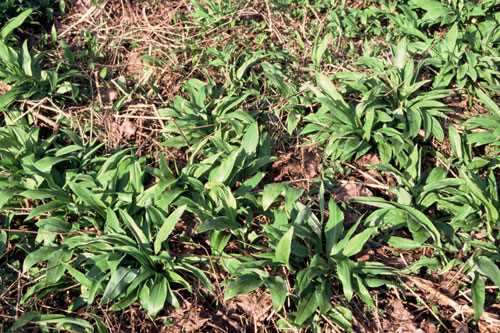
Wild garlic is tastiest before flowering.
It is widespread in damp fertile woods throughout most of northern Eurasia. You can find it in all regions of Poland but it is common only in the hills of southern Poland. Once you have found it you will see hundreds of meters or a few km carpets of it. It has very tasty leaves, which are fantastic in sandwiches and salads. Boiled or dried leaves lose most of their aroma but were added to soups in many countries, from Britain to Kamtchatka. Ramson is a popular vegetable in Ukraine, Russia and in the Caucasus (e.g. in Chechnya). In the second act of Chekhov�s drama entitled �The Three Sisters� a humorous dialogue about ramson appears. In the springtime the markets of many former Soviet Union cities are filled with people selling ramsons collected from the woods. If you are not sure ask for �chemsha� or �cheremesha�. You can also get it preserved salted or prepared like sauerkraut. In Germany it is becoming more and more popular to eat chopped ramson leaves served with salt and olive oil. Bulbs are also dug out in Caucasus. As I found on a web page they are served ground, with chilli (or maybe some other kind of red pepper) and cream.
Ramson is a spring bulb, like snowdrops or bluebells. So it produces new leaves in early spring. They are best collected before the flowering period in May, when they become fibrous and less aromatic. They gradually get yellow and dry out in summer.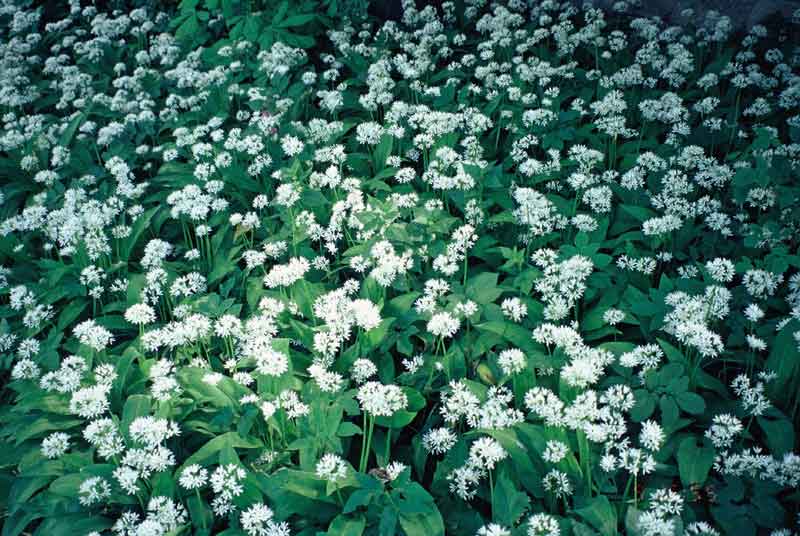
In the flowering stage (in May) wild garlic leaves become fibrous but they are still edible.
Another ramson-like garlic species is Allium victoriale. In Poland it occurs rarely, only in the mountains. It develops later than Allium ursinum. It is commonly eaten in Siberia and China.
|| BACK TO HOMEPAGE ||